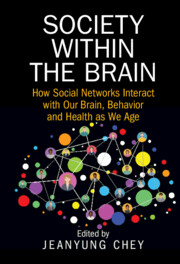Book contents
- Society within the Brain
- Society within the Brain
- Copyright page
- Dedication
- Contents
- Figures
- Tables
- Contributors
- Preface
- Introduction
- Part I Approaches to Society within the Brain
- Chapter 1 A Case of a Rapidly Aging Society and Its Dementia Population
- Chapter 2 Social Network Positions and Health Status in Older Adults
- Chapter 3 The Social Brain and How It Links Social Intelligence and Well-Being
- Chapter 4 The Genomics of Cognitive Aging in Social Isolation
- Part II Society Interacting with Brain, Cognition, and Health in Late Life
- Part III An Individual’s Cognitive Aging with Others: Key Findings, Issues, and Implications
- Index
- References
Chapter 3 - The Social Brain and How It Links Social Intelligence and Well-Being
from Part I - Approaches to Society within the Brain
Published online by Cambridge University Press: 28 September 2023
- Society within the Brain
- Society within the Brain
- Copyright page
- Dedication
- Contents
- Figures
- Tables
- Contributors
- Preface
- Introduction
- Part I Approaches to Society within the Brain
- Chapter 1 A Case of a Rapidly Aging Society and Its Dementia Population
- Chapter 2 Social Network Positions and Health Status in Older Adults
- Chapter 3 The Social Brain and How It Links Social Intelligence and Well-Being
- Chapter 4 The Genomics of Cognitive Aging in Social Isolation
- Part II Society Interacting with Brain, Cognition, and Health in Late Life
- Part III An Individual’s Cognitive Aging with Others: Key Findings, Issues, and Implications
- Index
- References
Summary
Human beings are dependent on each other in acquiring resources, securing safety, and raising offspring. Therefore, cooperation with conspecifics is essential for our survival and reproduction. Our evolutionary history has shaped strong social motivation and highly sophisticated socio-cognitive capacity that supports successful communal living. In this chapter, we review psychological and neuroscientific studies on the basic human motivation for social affiliation and social intelligence in humans. After introducing the belongingness hypothesis and the social intelligence hypothesis, we look into the functions of the social brain to understand how the human brain understands the complex social world and adjusts our behavior within it. Lastly, we briefly review the studies on aging in the social brain and discuss the link between the social brain and well-being.
Keywords
- Type
- Chapter
- Information
- Society within the BrainHow Social Networks Interact with Our Brain, Behavior and Health as We Age, pp. 69 - 104Publisher: Cambridge University PressPrint publication year: 2023



